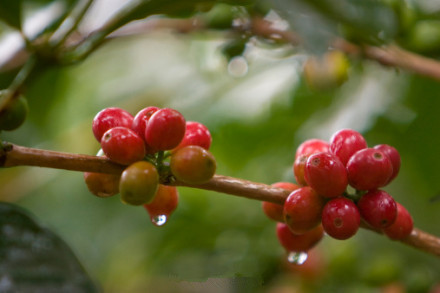High-quality coffee, coffee, common sense, production of coffee beans.
Coffee in the ancient Middle East, like the legend of 1001 nights, like a veiled girl with a thousand faces, can not only help get close to God, but also wash the spring of sadness. When it comes to coffee, we have to mention Turkish coffee in the Middle East, because no matter from the perspective of Islam or Christianity, the origin of coffee is in the remote and mysterious Middle East. During the thirteenth and fifteenth centuries, for as long as three hundred years, it was a forbidden role of Islamic religion. Coffee was officially introduced into Turkey in the 16th century, began to be commercialized, and quickly spread to the European continent. This coffee drinking method, commonly known as Turkish coffee or Arabica coffee, which is popular in Greece, Eastern Europe, the Middle East and North Africa, still retains the mystery of early religious rituals. The traditional practice of Turkish coffee is to grind roasted black coffee beans into fine powder and put sugar and cold water into a deep spoon-like coffee brewer of red copper (IBRIK).

Coffee beans refined in this way are slightly sour and slightly bitter. Almost all coffee beans produced in Brazil and coffee beans in Ethiopia, Yemen and other places are obtained in this way. The disadvantage of this method is that it is easily affected by the weather and is easy to be mixed with defective beans and other impurities. Therefore, it must be carefully screened.
Washing type:
Put the harvested fruit into a flowing tank, remove the floating fruit, and peel off the skin and flesh with a pulp remover. Then put it in the sink to remove the emerging pulp. After that, move into the fermentation tank, soak for half a day to a day, and then dissolve the gum on the surface of the fermented coffee beans.
After washing with water, drying it for a few days, drying it by machine, and finally using a sheller to remove the endocarp to become raw coffee beans that can be used as a commodity. In this way, it has a better color and less impurities than dried coffee beans. Colombia, Mexico, Guatemala and other countries use this method for about 70% of their coffee.
Judgment of appearance
Delicious coffee can be known from the shape of its roasted coffee beans. Of course, there can not be bad coffee beans mixed in, it is more important to note that normal beans will also be mixed with high-quality coffee beans and cause hindrance. A coffee bean that can brew delicious coffee must, first of all, be fat and crepe evenly, followed by the same size and colorless spots. These are the main points of visual discrimination, and it is not difficult to distinguish them if you look at them carefully.
Bad bean species
Fermented beans fermented coffee beans that fall from the soil before harvest. The moldy smell will have a great impact on the taste of coffee.
Dead beans, also known as unripe beans, or affected by climatic factors, the development is not perfect. Fried spots will be produced after baking, making the coffee have a green and astringent taste.
Black beans fermented beans, coffee beans that have rotted and blackened. Because it is black, it can be distinguished from normal coffee beans at a glance.
Moth beans Coffee beans infested by insects.
Defective beans may be stuck during work, or carelessly handled during handling, resulting in incomplete coffee beans. There are fried spots when baking, and will produce bitter and astringent taste.
Other remaining thin-skinned beans, stunted beans, dried beans that do not completely produce moldy flavor, only shell beans (shell beans)
Important Notice :
前街咖啡 FrontStreet Coffee has moved to new addredd:
FrontStreet Coffee Address: 315,Donghua East Road,GuangZhou
Tel:020 38364473
- Prev

Fine coffee, common sense, size and specification of coffee beans.
A, coffee can be divided into washing type and non-washing type according to specifications, and can also be divided into flat beans and round beans. Washing type: in the sink, after rubbing with water and utensils, the pulp and colloid are removed and dried, which is called washing coffee bean with uniform quality. Non-washing type: after the sun is naturally dried, the pulp and peel is removed by a sheller, and its quality is unstable. The fruit of coffee is made up of two oval shapes
- Next

Roasting technology of boutique coffee beans coffee roasting knowledge
When high-quality coffee beans are picked, the most important step in making them gourmet coffee is roasting and mixing. A master baker must have the temperament of an artist and the rigor of a scientist. Only in this way can we ensure that the sugars and other carbohydrates in the coffee are carbonized during the baking process, thus producing the well-known coffee oil and producing high quality and consistent style.
Related
- Beginners will see the "Coffee pull flower" guide!
- What is the difference between ice blog purified milk and ordinary milk coffee?
- Why is the Philippines the largest producer of crops in Liberia?
- For coffee extraction, should the fine powder be retained?
- How does extracted espresso fill pressed powder? How much strength does it take to press the powder?
- How to make jasmine cold extract coffee? Is the jasmine + latte good?
- Will this little toy really make the coffee taste better? How does Lily Drip affect coffee extraction?
- Will the action of slapping the filter cup also affect coffee extraction?
- What's the difference between powder-to-water ratio and powder-to-liquid ratio?
- What is the Ethiopian local species? What does it have to do with Heirloom native species?

